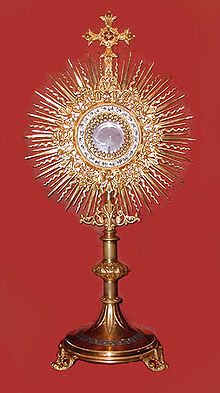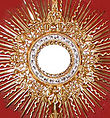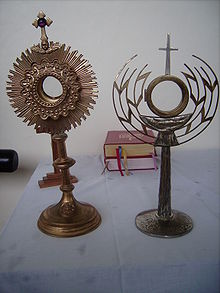Monstrance

| Part of a series on |
| Eucharistic adoration of the Catholic Church |
|---|
 |
| Papal documents |
| Organisations and events |
|
| Notable individuals |
| Eucharistic meditators |
|
|
Catholicism portal |
This article needs additional citations for verification. (March 2024) |
A monstrance, also known as an ostensorium (or an ostensory),
Liturgical context
In the
.Other Christians (notably in the
Within churches of these traditions the reserved sacrament serves as a focal point of religious devotion. In many of them, during Eucharistic adoration, the celebrant displays the sacrament in the monstrance, typically on the
Use and design


In the service of
Monstrances are usually elaborate in design; most are carried by the priest. Others may be much larger fixed constructions, typically for displaying the host in a special side chapel, often called the "Chapel of the Blessed Sacrament". For portable designs, the preferred form is a sunburst[4] on a stand, usually topped by a cross.
Before the Council of Trent, the most common design was the tower.[5] The sun design derives from Latin American Catholicism, where missionaries employed monstrances with the sunburst to appropriate sun imagery to the eucharist, and hence supplant sun worship among the natives.[6][7]
Medieval monstrances were more varied in form than contemporary ones. Those used for relics, and occasionally for the host, typically had a crystal cylinder in a golden stand, and those usually used for hosts had a crystal window in a flat-faced golden construction, which could stand on its base. The monstrance was most often made of
Noted monstrances
- The monstrance of Corpus Christi at the Cathedral of Valencia (Spain) - Every year, during the Corpus Christi procession in Valencia, the largest Monstrance in the world, made of 600 kilograms (1,300 lb) of silver, 5 kilograms (11 lb) of gold, 75 grams (2.6 oz) of platinum, hundreds of precious stones and thousands of pearls, runs through the streets of Valencia under a shower of flower petals.[8]
- Banco de la Republica of Colombia. It consists of 9 kilograms (20 lb) of 18 karat gold, 1,485 emeralds which gave the name to the piece due to its color, and other gems from various parts of the world.[9]
- The Cathedral of Toledo, Spain, boasts one of the most famous monstrances in European medieval history. Made of pure gold (the first gold brought over from the New World by Admiral Columbus)[10] and encrusted with several jewels, it has merited several papal processions, acclamations and uses. Most recently among these is Pope Benedict XVI in his World Youth DayApostolic Visit in 2011. It has also been immortalized in several 18th-century and 19th-century devotional handbooks. This portable monstrance (or ostensory) is housed within a second, fixed monstrance made of partially gilded silver.
- The Vatican monstrance (Latin: Ostensorio Vaticana) of is one of the most exquisite monstrances used by recent popes, as it is an exact miniature of the Baldachin inside St. Peter's Basilica. It is complete in ornamentation including the angels adorning its rooftop. It was most recently used by Pope Benedict XVI.
- Raymond Nonnatus and Clare of Assisi are often portrayed with monstrances. Nonnatus used a Gothic box-style monstrance while Clare is often portrayed with a solar version.
- Founderess of the Eternal World Television Network, Mother Angelica of the Annunciation, was often portrayed with a golden solar monstrance pendant.
- The The Divine Mercy, which is being constructed adjacent to the church. The Monstrance is to be installed in the sanctuary's adoration chapel, to be the focus of 24-hour Eucharistic Adoration. The clergy will conduct no liturgies or vocal prayers in the chapel, either by individuals or groups, as the space is meant for private meditation and contemplation.
- In the treasury at the St. Loreta Church in Prague, there is on display a monstrance featuring 6,000 diamonds.
- On top of the main dome of the Płock, Poland, is a large monstrance. The monstrance is adorned with four angels, each measuring almost 4 feet (1.2 m) in height. The following Polish phrase is inscribed below the monstrance: Adorujmy Chrystusa Króla panującego nad narodami (in English, "Let us adore Christ the Kingreigning over all nations".)
- St. Francis Xavier Mission in 1686, located at what is now modern Green Bay, Wisconsin. It was buried by the priests when the local Indians became hostile and burned the mission buildings. It was dug up by accident in 1802 and is currently in the Neville Public Museum in Green Bay, Wisconsin. It is the oldest surviving physical artifact of French settlement west of the Alleghenies.[11]
Gallery
For displaying the sacred host
-
Monstrance given to the Monastery of Alcobaça by Dom João Dornelas in 1412, with some later additions during the baroque period, National Museum of Ancient Art, Portugal.
-
The large Patriarchal Monstrance was a gift from king D. João V to the Patriarchal Cathedral of Lisbon, and is made of solid gold, diamonds, rubies, sapphires and emeralds. It was commissioned in 1748, Lisbon Cathedral Museum, Portugal.
-
Belém Monstrance; gold and enamel monstrance made in 1506 by Gil Vicente, and offered by king Dom Manuel I of Portugal to the Jerónimos Monastery. Nowadays in the National Museum of Ancient Art, Portugal.
-
Late 18th to early 19th century 1,30 metres monstranceAsilo de Inválidos Militares de Runa, Portugal.
-
Monument with a Monstrance in Rybnik, Poland in front of the Church of St. Laurence.
-
Bemposta Monstrance; 18th-century silver gilt diamonds, emeralds, rubies, etc. National Museum of Ancient Art, Portugal.
-
Monstrance ofCathedral of Toledo. Spain.
-
18th century Portuguese silver gilt and gems, National Museum of Ancient Art, Portugal.
-
Fixed monstrance in theOld Catholic church in Oudewater, the Netherlands.
-
Polish Rococo monstrances.
-
Monstrance from the museum of the Melk Abbey, Austria.
-
Monstrance from the museum in Pelplin, Poland.
-
a 16th-century design for a Monstrance by Daniel Hopfer.
-
Monstrance as part of achurchin Warsaw, Poland.
As reliquaries
-
Cologne, Germany.
-
Monstrance with a relic of SaintMinalin Church in Pampanga, Philippines.
-
A relic of SaintMinalin Church in Pampanga, Philippines.
See also
References
- ^ "Altar vessels". New Advent Catholic Encyclopedia. Retrieved on 2014-11-16.
- ^ a b "". New Advent Catholic Encyclopedia. Retrieved on 2014-11-16.
- ^ "Demonstrate", The American Heritage Dictionary, men in Appendix I, Indo-European Roots
- ^ Instructio Clement, 5.
- OCLC 1056201987.)
{{cite book}}: CS1 maint: location missing publisher (link - OCLC 883343728.
- OCLC 181599761.
- ^ "Museo Catedralicio Diocesano".
- ^ "La Lechuga". banrepcultural.org. Retrieved 2020-06-27.
- ^ catedralprimada.es. "Catedral Primada Toledo". Catedral Primada Toledo (in Spanish). Retrieved 2020-06-27.
- ^ Butler, J.D. (February 1880). "Nicolas Perrot's ostensorium". Watchman. Green Bay. Retrieved November 6, 2014.
External links
 This article incorporates text from a publication now in the public domain: Herbermann, Charles, ed. (1913). "Ostensorium". Catholic Encyclopedia. New York: Robert Appleton Company.
This article incorporates text from a publication now in the public domain: Herbermann, Charles, ed. (1913). "Ostensorium". Catholic Encyclopedia. New York: Robert Appleton Company.




















